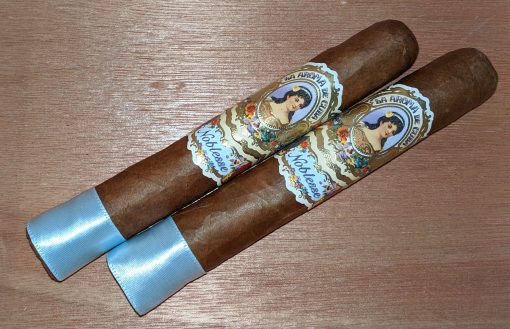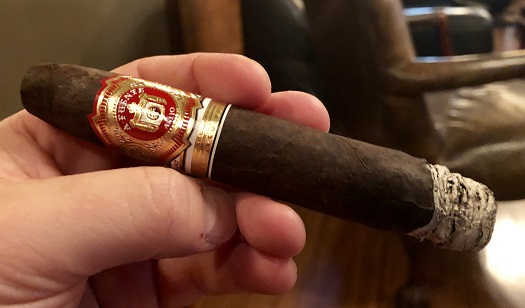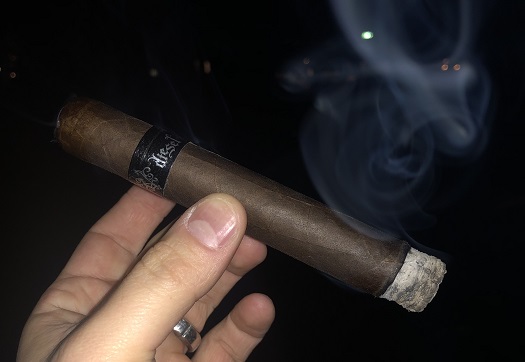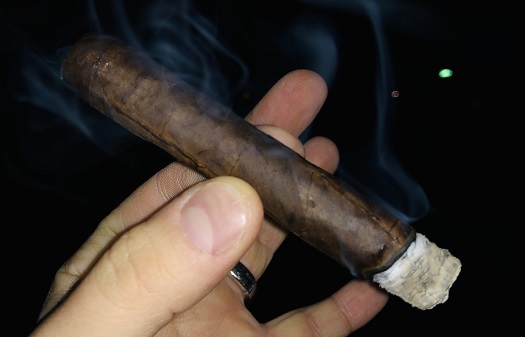Cigar Review: Hoyo de Monterrey Excalibur Epicure
11 Feb 2019
 When I started smoking cigars, the Hoyo de Monterrey Excalibur was my first real go-to smoke. I went through lots of them. I was captivated by the smooth, creamy texture and strength that seemed ideally suitable for my palate. Some years later, in 2006, I reviewed the Excalibur Epicure and gave it four stogies.
When I started smoking cigars, the Hoyo de Monterrey Excalibur was my first real go-to smoke. I went through lots of them. I was captivated by the smooth, creamy texture and strength that seemed ideally suitable for my palate. Some years later, in 2006, I reviewed the Excalibur Epicure and gave it four stogies.
In that review, I remarked that I could remember the first one I smoked. I still do. It was at Signature Cigars in Rockville, Maryland. Although I’d had other cigars, this was the one that really made an impression and let me know smoking cigars could be something special.
I think it was recently enjoying the Tatuaje Verocú that got me to thinking about other cigars I hadn’t had in a while. So I bought a five-pack of Epicures, a robusto (5.25 x 50). They retail these days for a little under $8, but I picked them up online for under $3 each. Quite a bargain.
At first glance, Excalibur looked exactly as I remembered with a smooth, golden brown Connecticut shade wrapper. When I lit one up, I felt I could have been back in that Maryland cigar lounge.
The tasty blend of Dominican, Honduran, and Nicaraguan filler inside a Connecticut Broadleaf binder hit the spot. It started with a bit of pepper mixed with sweetness. For a few more puffs, the pepper increased then faded as I tasted some wood and coffee.
There weren’t a lot of changes, but that was by no means a negative, as the Excalibur was satisfying from beginning to end. Each of those I’ve smoked burned evenly, produced lots of smoke, and had an excellent draw.
When Excalibur was introduced in the early 1990s, it was designed to be a bit less powerful than the regular Hoyo do Monterrey line. It was a hit during the cigar boom and continues to sell.
These days there are 18 vitolas, including Natural and Maduro. They range in size from a 3-inch miniature to the 7.25-inch No. 1.
I recommended them before. I recommend them again. Excalibur is a fine cigar still worthy of four stogies.

[To read more StogieGuys.com cigar reviews, please click here.]
photo credit: Stogie Guys






 I must have seen enough ads for Diesel because, on more than one occasion, I ponied up for some Unholy Cocktails. “Some liken a fine cigar to a harmonious symphony,†I wrote of the
I must have seen enough ads for Diesel because, on more than one occasion, I ponied up for some Unholy Cocktails. “Some liken a fine cigar to a harmonious symphony,†I wrote of the 
 The cigar became known as Liga Privada No. 9. It forever changed the way the cigar world thinks about Drew Estate, which had formerly been known for its infused cigars.
The cigar became known as Liga Privada No. 9. It forever changed the way the cigar world thinks about Drew Estate, which had formerly been known for its infused cigars.
 Antaño Dark Corojo was the first Joya I ever smoked. It would be safe to say it played a big role in shaping my perception of what a Nicaraguan cigar should be. These days, I’ve smoked enough Antaño Dark Corojos to know that the proper setting for this cigar is after a large meal, in the evening, paired with a nice sipping rum or a neat bourbon. This is the best way to enjoy what Joya calls “the embodiment of the Nicaraguan power cigar.â€
Antaño Dark Corojo was the first Joya I ever smoked. It would be safe to say it played a big role in shaping my perception of what a Nicaraguan cigar should be. These days, I’ve smoked enough Antaño Dark Corojos to know that the proper setting for this cigar is after a large meal, in the evening, paired with a nice sipping rum or a neat bourbon. This is the best way to enjoy what Joya calls “the embodiment of the Nicaraguan power cigar.â€
 All the tobaccos employed are grown and cultivated at Fernandez’s own farms in EstelÃ, rendering the line a living tribute to a region that has worldwide become synonymous with premium cigars. The cigars are made at Tabacalera A.J. Fernandez Cigars, which is located—you guessed it—in EstelÃ. (Side note: That factory started with just six rollers; today, it is one of the largest factories in Nicaragua and produces over 9 million cigars annually.)
All the tobaccos employed are grown and cultivated at Fernandez’s own farms in EstelÃ, rendering the line a living tribute to a region that has worldwide become synonymous with premium cigars. The cigars are made at Tabacalera A.J. Fernandez Cigars, which is located—you guessed it—in EstelÃ. (Side note: That factory started with just six rollers; today, it is one of the largest factories in Nicaragua and produces over 9 million cigars annually.) Patrick Ashby
Co-Founder & Editor in Chief
Patrick Ashby
Co-Founder & Editor in Chief Patrick Semmens
Co-Founder & Publisher
Patrick Semmens
Co-Founder & Publisher George Edmonson
Tampa Bureau Chief
George Edmonson
Tampa Bureau Chief